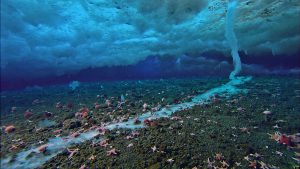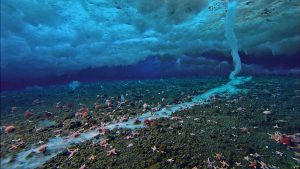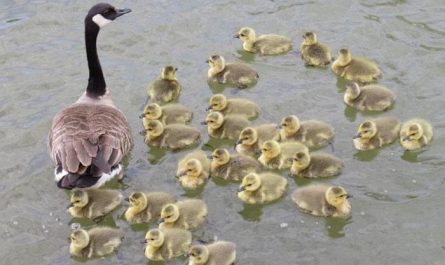For the first time ever, breathtaking footage has captured the formation of an eerie natural phenomenon known as the “ice finger of death.”
In today’s world, discovering something entirely new to science is rare, yet every now and then, a groundbreaking revelation expands our understanding of nature. Just as uncontacted tribes, unseen caves, and deep-sea creatures have amazed us in recent years, the Antarctic brinicle—commonly referred to as an “ice finger of death”—has now been brought into the spotlight through stunning video footage.

Brinicles are surreal, finger-like ice structures that descend from floating sea ice into the frigid Antarctic waters. Though scientists have known of their existence since the 1960s, they are seldom observed in real-time. These icy formations require precise conditions to develop, forming only in Earth’s polar regions beneath floating sea ice. Their elusive nature has made capturing them on film nearly impossible—until now. This is what makes the footage from BBC’s Frozen Planet series (Season 1, Episode 5) so remarkable.
Unlike frozen freshwater, sea ice consists of two distinct components. As ocean water freezes, it expels most of its salt, leaving the ice relatively pure. However, this process also creates excess saline water. Since this briny solution requires much lower temperatures to freeze, it remains in liquid form, flowing through tiny channels within the porous ice.
A brinicle forms when cracks in the floating sea ice allow this highly saline solution to leak into the open ocean below. Because the brine is denser than the surrounding seawater, it sinks, rapidly freezing the relatively fresh water it encounters along the way. This causes the brinicle to grow downward in a striking, finger-like formation.

Dr. Andrew Thurber, one of the few scientists to witness brinicle formation firsthand, describes the eerie spectacle: “They look like upside-down cacti, as if they were blown from glass—something straight out of Dr. Seuss’s imagination. They are incredibly fragile and can break with the slightest touch.”
At Little Razor Back Island, Antarctica, a 3-meter-deep area is home to thousands of these delicate ice fingers, which often stretch all the way to the seafloor. Among them live thousands of amphipods—small, shrimp-like creatures—swimming through the icy waters. When disturbed, they react much like a swarm of bees.
However, for marine life in the area, these fragile ice tubes conceal a lethal secret. As seen in the newly captured footage, a brinicle that reaches the seafloor continues to expand, potentially trapping sea creatures like starfish and sea urchins, freezing them in place.

“In areas where brinicles have been active or where they’ve previously formed, pools of highly concentrated brine—what we call ‘black pools of death’—can develop,” Thurber explains. “They may appear clear, but they often contain the remains of marine animals that have unknowingly wandered into them.”
With the scientific study of brinicles still in its early stages, this groundbreaking footage provides the first-ever real-time evidence of these mysterious and deadly icy formations.



